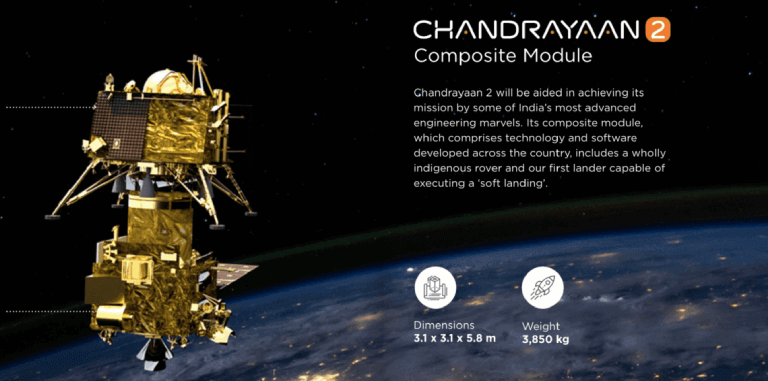
In this article, we are going to tell you about India’s prestigious Chandrayaan Mission.
India launched its most ambitious space mission, Chandrayaan 2 finally. The mission was launched from India’s most powerful rocket GSLC-Mklll, which lifted off from the Sriharikota spaceport. The Rover is even scheduled to land on the 7th of September 2019 on the lunar South Pole, which is the completely uncharted territory of the moon.
So far as of now, only three other countries have successfully carried out a moon landing; those countries are China, USA, and Russia. India has taken a giant leap towards the launching of this cost-effective space program on the quest to explore the lunar south pole. The mission is programmed to undertake the 15 manoeuvres over the period of around 48-day journey towards the moon.
The main objective of this mission is to map the moon surface to trace origin, study the evolution of the moon, examine the water level on and below the moon surface and to study lunar topography, surface composition and minerals of the moon, the entire mission costs around INR 978 crore to the Government of India.
Chandrayaan 2 is one of a kind missions because it will be the first space mission in the entire human history to land on the south polar region of the moon. This is also the India first attempt at launching a space expedition aimed at landing on the moon that is fully designed and made with the homegrown technology. If India succeeds in Landing the Chandrayaan 2 on the lunar surface, then it will become the fourth company in human history to soft-land on the moon’s surface.
Chandrayaan 2 was launched by the GSLV MK-III, which has been completely designed and manufactured in India. Chandrayaan 2 is carrying around 14 payloads which weigh around 3853 kgs, the heaviest payload carried by an Indian rocket. The payload includes the Pragyan Rover, Orbiter and Vikram lander.
The Orbiter is designed to monitor the moon surface and facilitate the communication between the Vikram and Earth. Vikram Lander will land on the surface of the moon, executing the India soft landing on the moon. Pragyan Rover is facilitated with the Artificial Intelligence technology comprising of 6 wheels to move along the moon surface and gather data.
Prime Minister Modi has expressed jubilation and pride regarding this mission, which states that the main goal of this mission is to encourage the young minds to explore science and space as a viable career option. The entire mission is devices to provide entirely new information to humankind about the moon.
Some impressive Indian women scientists have been instrumental in dubbing India as an emerging space super. Ms Anuradha TK, Ms Nandini Harinath, and Ms Ritu Karidhal have been at the forefront of the Mars Orbiter Mission.
From the past so many years, ISRO has become synonymous with the national pride in India. With an increase in space mission launched by the Government of India, there has been a steep rise in a wide range of job opportunities in the country. This is the right time to consider a career in aerospace engineering. Aerospace engineers are in high demand by the private and public sector companies in India.
Chandrayaan 2 – India’s second Lunar Mission
Chandrayaan 2 is an Indian lunar mission that will help to explore the Moon south polar region. No country has ever gone there before. The launch vehicle will be carrying an Orbiter, a rover named Pragyan and a lander named Vikram.
Chandrayaan 2 mission was launched on the 22nd of July 2019 and is even expected to land on the 7th of September 2019. The mission life of the Orbiter will be one year whereas the mission life of the Vikram lander and Rover will be on Lunar day, which is equal to the fourteen earth days.
Chandrayaan Program – India’s Lunar Mission
Indian Lunar Exploration, Programme is called Chandrayaan. In Sanskrit, it means “Moon Craft.” It is the brainchild of the Indian Space Research organization.
Chandrayaan is a multiple mission program, which is planned to be conducted in three phases – Chan1, Chandrayaan 2, Chandrayaan3.
The Chandrayaan 1 was planned as an impactor/orbiter, Chandrayaan 2 contains the soft landers/rovers while on the other hand, Chandrayaan 2 is intended for in situ samplings.
Chandrayaan 1 vs. Chandrayaan 2
The Chandrayaan 1 mission was launched in the October 2008 and was active in operations until August 2009. The mission launched a lunar orbiter and an impactor. The Chandrayaan 1 mission was launched with the help of PSLC-XL rocket, serial number C11 from the Satish Dhawan Space Center located in Sriharikota.
Chandrayaan 2 mission was launched from the Sriharikota Space Center on the 22nd of July 2019 to the Moon by a Geosynchronous Satellite Launch Vehicle Mark III. It includes a lunar orbiter, lander, and rover all developed domestically. The main scientific objective is to map the location and abundance of lunar water.
Just like a Chandrayaan 1, Chandrayaan 2 will attempt to soft-land its Vikram module on the lunar surface and deploy a six-wheeled Rover, Pragyaan on the Moon to carry out several scientific experiments. The lift-off mass of the Chandrayaan 1 was 1380 kg while on the other hand Chandrayaan 2 weighs around 3850 kg.
Chandrayaan 2 Components
Launcher: The GSLV MK-III is India’s most powerful launcher to date and has been completely designed and fabricated from within the country.
Orbiter: The Orbiter will observe the lunar surface and relay communication between the Earth and Chandrayaan 2 Lander – Vikram.
Lander: The Lander called by the name as ‘Vikram’ is designed to execute the India first soft landing on the lunar surface. ‘Vikram’ is named after the space luminary, Dr Vikram A Sarabhai, who widespread India nascent space program.
Rover: The Rover is a 6-wheeled, AI-powered and supported vehicle named Pragyan, which translates to ‘wisdom’ in Sanskrit. The Rover can travel around 500 meters from the landing spot on the moon.
Chandrayaan 2 landing site
Chandrayaan 2 will be taking an attempt at landing a lander, and the moon rover in a high plain situated between the two creators called as Simpleius N and Manzinus C. the location has a latitude of around 70 degrees south.
The lunar south pole is especially interesting because of the lunar surface area here that also remains in shadow is much larger than that at the North Pole. There is a possibility off the presence of water in permanently shadowed areas around it. Moreover, the south pole region has craters are cold traps and contain a fossil record of the early solar system.
Did you know?
The Chandrayaan 2 mission was initially supposed to launch on the 15th of July 2019 but was called off because of lack of pressure in the helium tanks onboard the GSLV MK III launch the vehicle.
6 Amazing Facts About Chandrayaan 2 Mission
1. Chandrayaan 2 Will Explore The Unexplored Part Of The Moon
Chandrayaan 2 is the first lunar spacecraft that will explore the south pole of the moon, something that no country has ever done before. Chandrayaan 1, which was launched in 2008, helped confirm the presence of water on the moon surface. But the south pole of the moon is permanently shadowed and is reported to contain almost 250 tones of water ice in the numerous deep craters. Chandrayaan 2 aims to confirm these reports.
2. Chandrayaan 2 Mission Is Headed By Two Women Scientists
The efforts and contribution of the project director M. Vanitha and mission director Ritu have been tremendous. Karidhal was also the deputy operations director for the Mangalyaan and is also popularly known as the “Rocket Woman of India.” With the help of this mission, M. Vanitha made history by becoming the first-ever female project director at the ISRO.
3. Chandrayaan 2 Mission Was Made With Less Than Half The Budget Of Avengers: Endgame
You would think that a large-scaled lunar mission like this is even bounded to cost a whole lot off money. But on the contrary, the Chandrayaan 2 mission only costs around INR 960 crore, which makes it the cheapest aircraft ever built for a lunar mission of this scale. This might still seem like a lot, but to give you a clearer picture, the firm Avengers: Endgame has a budget of around INR 2400 crore.
4. The Role Of Pragyan and Vikram
Chandrayaan consists of an orbiter, lander, and rover. Vikram is the lander module that will station itself on the surface of the moon. It contains the rover Pragyan within itself and will deploy it as soon as it successfully lands on the moon’s surface. It is named after the father of the Indian space program, Vikram Sarabhai.
Pragyan is a six-wheeled rover that has the duty of scouting the surface and directly communicating the information to Vikram. All these parts will carry a series of payloads that will study various aspects like lunar topography, seismography, mineral identification, surface chemical composition, and temperatures of the moon.
5. How Scientists Made The Most Of Everything
ISRO wanted to test the rover Pragyan on surfaces and conditions similar to that of the moon. The moon’s surface is covered with dust, sharp rocks, deep craters and is composed of soil with a very different texture. Importing that kind of lunar soil from the US would cost a lot, according to a report by IANS. But quite a few geologists told ISRO that an area near Salem in Tamil Nadu consisted of “anorthosite” rocks that have features similar to the moon soil. ISRO decided to get these “anorthosite” rocks to Bengaluru, where they were crushed and incorporated in the testbed of the Lunar Terrain Test Facility.
6. Chandrayaan Could Find Particles From Four Billion Years Ago
The moon is a living floating piece of evidence. The craters and particles are scars of the ever-changing universe, and they could tell us a lot about our past. Pragyan the rover will scan the topsoil by blasting it with lasers. Apart from water, Pragyan will be searching for elements that could have been part of a magma ocean from almost four billion years ago.






